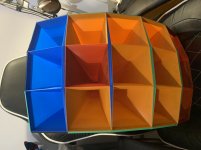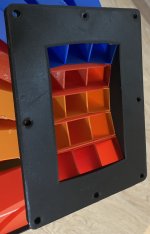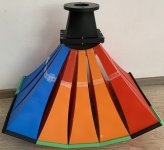If the printed multicell horn works, it would be quite the play-garden to check out several options!
Pelanj,GM, on the pictures you linked, it looks like the thin walls are deformed to touch as much as possible and the corners are filled with solder. This could be solved in 3D by slighty deforming the cells at both ends so that no gaps after gluing appear. Would that be worth it? That would lead to 4 different kinds of cells if I am counting correctly (corners, upper+lower outer, middle, left+right outer).
You should be using a liberal amount of filler (epoxy?) to bond all the throats together as if they were a single casting. This should leave some filler oozing out, you will want to file the joints to a (butter) knife edge.
Deforming the cells at both ends would require only a little bit less finish work, probably not worth the print/design effort, especially since you already have finished 15 cells and the front fillers.
The printed plastic horn cells should be more inert than sheet metal, but would still benefit from a layer of damping material.
Art
Yes I agree, you are going to want to damp them. But of course you should listen to them as they are before you begin to "improve" them. 

The horn is ready to be filled with foam. The adaptor test print was quite successful, it needs just some minor adjustments. It could be even used as is with a bit of putty. Before gluing it on, I will use some Revel Plasto on the throat area and also on the mouth to fill the gaps. The construction is pretty strong as is when glued together. If the foam will not rip it apart, it shoud be really well damped.
Attachments
Looking great!
If you are using expanding foam, be careful, get the foam expansion rate sorted out- I've bent 5mm thick fiberglass horns with it, the cracking noises were distressing..
If you are using expanding foam, be careful, get the foam expansion rate sorted out- I've bent 5mm thick fiberglass horns with it, the cracking noises were distressing..
I wonder if enough foam can be injected to damp it; there's a reason the pioneers used tar and its 'el cheapo' replacement, sprayed on Aquaplas didn't IME do enough damping for HIFI apps.
So when the throat adapter is printed and glued, I will try some rough measurements and listening. Foam will follow later, since the thing might not survive intact. I was thinking about self adhesive tar sheets (like used in cars) for damping the outer surfaces.
I need to buy some putty tomorrow, all I had dried out. After adjustment, the flange fits well. The last part of the throat adaptor is being printed. I have enjoyed the project so far and hope that the sound will be worth the effort, I really like how it looks, and how it could look if done properly🙂
Attachments
I wonder if tar based paint, that is used for car chassis bottom protection, would dampen the cells enough. With a bit of patience and a long brush, it would be possible to paint it everywhere inside. I was also considering fine sand filling, plugs could be 3D printed amd glued.
It does look impressive.  And that throat adapter is very professional looking.
And that throat adapter is very professional looking.
Tar that stays soft will work well, I've done it several times. The paint isn't as thick so not as good, but I've used it mixed with sand.
If you want to sand fill these, proceed with caution because the sand can crush thin walls. And it's going to be heavy. Sand is very effective, for sure.
 And that throat adapter is very professional looking.
And that throat adapter is very professional looking.Tar that stays soft will work well, I've done it several times. The paint isn't as thick so not as good, but I've used it mixed with sand.
If you want to sand fill these, proceed with caution because the sand can crush thin walls. And it's going to be heavy. Sand is very effective, for sure.
Pelanj,
Roof or car tar paint should work OK, pretty much what all the old horns had coated on them. Takes a long (stinky) time to dry when you put it on thick..
I didn't realize till your photo with the throat adapter complete how small your multicell is compared to the usual, very petite!
It would be interesting to see polar plots comparing your horn using the same driver to the 2380 at the same drive levels and angles, preferably with angles on and between cell axis points.
Art
Roof or car tar paint should work OK, pretty much what all the old horns had coated on them. Takes a long (stinky) time to dry when you put it on thick..
I didn't realize till your photo with the throat adapter complete how small your multicell is compared to the usual, very petite!
It would be interesting to see polar plots comparing your horn using the same driver to the 2380 at the same drive levels and angles, preferably with angles on and between cell axis points.
Art
I have just applied some filler, tomorrow will be sanding day🙂 I definitely want to make some polars and comparison to the 2380, but that will take some time since my rotating stand was not made for such big and heavy things, I need to prepare something more solid.
I estimate the volume of the free space around 12 - 15 liters. Everything except some foam will be heavy🙂
I estimate the volume of the free space around 12 - 15 liters. Everything except some foam will be heavy🙂
Yeah, that would be around 20 kilos of sand. Ooof! You don't want to lift those too often.
We used wool felt carpet pad stuffed between cells and got some improvement. It's not pretty, tho.
We used wool felt carpet pad stuffed between cells and got some improvement. It's not pretty, tho.
An idea to throw into the mix having seen these 3D printed versions - hexagonal horns are just as easy to print as square, and can be circular in internal cross-section more readily/efficiently, providing more intrinsic rigidity. Also octagonal with small gaps between might be interesting for the same reason.
I agree Mark and have been working on some different shapes, hexagon chief among them. Hexagon + pentagon makes a nice curved face with no gaps, but what to do with the edges? 3D printing does open up some fun avenues for shapes.
Does printing a hexagon or octagon cell of the same size as square take any more time?
Does printing a hexagon or octagon cell of the same size as square take any more time?
- Home
- Loudspeakers
- Multi-Way
- The construction of a multicell horn



